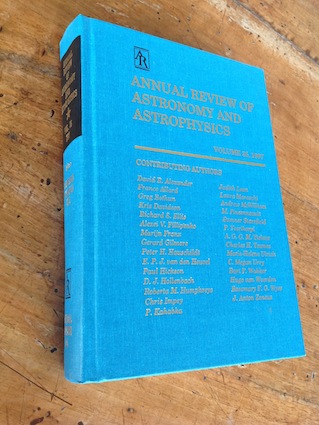The Observatory of Arcetri goes twice on ARAA
The Annual Review of Astronomy and Astrophysics (ARAA) is one of the most prestigious journals in Astronomy. It is published in the United States of America and it releases only one volume per year presenting about twenty articles solicited directly by the Editor Office to major experts in the different fields covered. The resulting book constitutes thus a reference for the most relevant and state-of-the-art advances on debated themes. The excellence of the Journal is witnessed by one of the highest Impact Factor. Researchers at the Observatory of Arcetri have contributed with two articles in two years to this Journal.
In the 2013 Issue (Volume 51), Daniele Galli and Francesco Palla, both researchers at the Observatory of Arcetri, have presented the article "The Dawn of Chemistry", a study of the chemical evolution of the gas in the Universe during the epoch of primordial nucleosynthesis (a few minutes after the Big Bang) until the formation of the first stars (about 400 million years after the Big Bang). During this time the first molecules, simple diatomic species such as H2, HD and LiH, were formed out of the elements present in the primordial gas, composed of hydrogen, helium and traces of deuterium and lithium. These molecules had a fundamental role in the cooling and fragmentation of the gas within the Dark Matter haloes that gave origin to the first stars that lit up the Universe. (See also The dawn of the chemical evolution of the universe)
The 2014 Issue (Volume 52) will contain an article on the systems that produce Type 1A Supernovae, authored by Filippo Mannucci, current Director of the Observatory of Arcetri, in collaboration with Dan Maoz from the University of Tel Aviv and Gijs Nelemans from Radboud University in the Netherlands ("Observational clues to the progenitors of Type-Ia supernovae"). This type of Supernovae are of central relevance in astrophysics as they produce the majority of the chemical elements found in the Universe. The award of the 2011 Nobel for Physics recognizes the importance of their use in Cosmology studies. Nonetheless, what causes these stellar explosions is still unknown. It seems clear that these Supernovae are the explosions of a White Dwarf disturbed by a companion star, but many other configurations are possible. In this article, F. Mannucci discusses the recent development in theoretical studies and the many observations carried out in the last years. These studies allow now to understand that the majority of these explosions are due not to one but two white dwarves that spiral in one toward the other emitting gravitational waves. This result will allow to better understand the chemical evolution in the Universe and to plan future supernova searches at cosmological distances.
Edited by Anna Gallazzi and Filippo Mannucci




